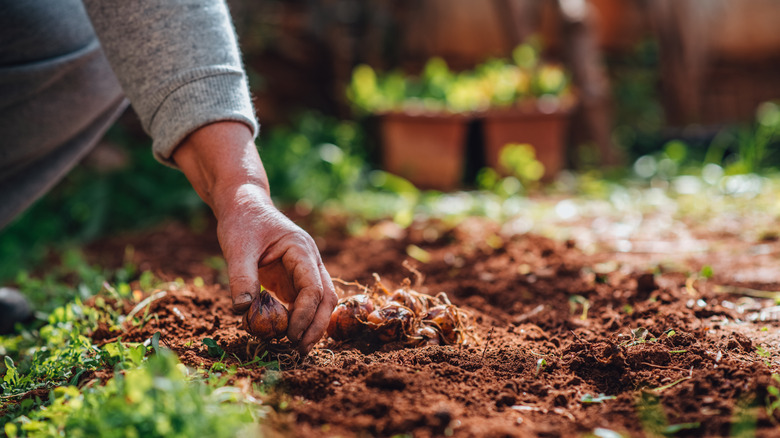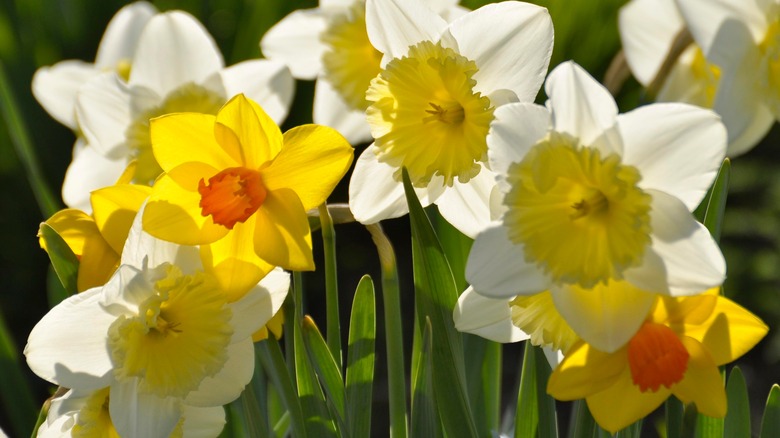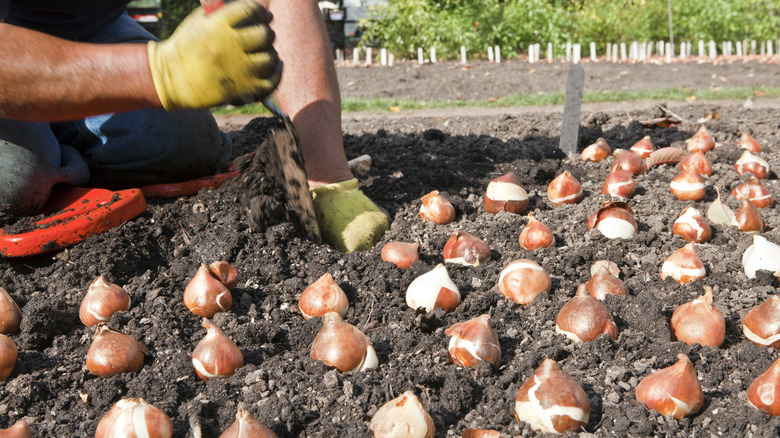How To Plant Your Bulbs For A Soft & Natural Look
Watching your fancy bulbs bloom in early spring will bring you out of the dreary winter mood. While it isn't unusual for gardeners to plant them in an orderly fashion in straight or geometrical grids or even in containers, such designs scream uniformity and rather seem like you're imitating a catalog design. Luckily, there's a better way to display your spectacular bulbs, giving them the au naturale and soft look reminiscent of a nature walk in the woodlands—without the woodland, of course. All you need to do is randomly fling your favorite tubers all over the turf and plant them at their landing positions. It might feel slightly messy, but if need be, you can rearrange the bulbs according to your aesthetic.
While a naturalistic bulb meadow isn't going to resemble a well-manicured lawn, it screams untamed energy and has a distinctive flow and cadence to it. If planted right, it emulates nature's self-flourishing habit, meaning it grows, spreads, and blooms over successive years without your assistance, yielding the biggest bang for your time, money, and effort. And if you cultivate several bulb varieties, you can rejoice in the presence of pollinators like bumblebees and honeybees. But to get the most out of them, plant them in ample sunlight, preferably as deciduous understory growth or as border clusters to soften the edges.
Designing a bulb garden
But before planting fall bulbs, ensure you've got a sound plan, as imitating nature's work is trickier than it looks. First, choose the varieties you want to cultivate. For a natural-looking garden, prefer the types that flower over successive years yet aren't weedy, are low maintenance, self-seeding, and adaptive. Snowdrops, daffodils, tulips, winter aconites, hyacinths, and alliums represent a microcosm of choices. As these varieties repeat the bloom-die-bloom cycle every year, coming back stronger when treated right, they naturally begin to realign their patterns akin to nature's undulating, graceful lines.
Next, pick a color. While you can stick to a consistent bulb variety and color to naturalize your flowers, creating drifts of different hues is also an option, especially in large expanses. However, ensure the shades complement and succeed each other, or else they'll look unnatural. Moreover, if you wish to intermix different varieties, select them carefully to layer them, preferably with the bigger bulbs like daffodils or lilies at the back of the planting area, flanked by smaller ones like squill and crocus toward the front.
Planting bulbs for a natural look
The golden rule to achieve a soft and natural-looking bulb meadow is to bid goodbye to systematic grids and patterns. Instead, create multiple clusters around your yard to give it a relaxed look. There are two ways to go about this. One, stick to a single bulb type and mass plant it—maybe even include several sub-varieties in clumps of 50 in smaller lawns. Gently throw the bulbs on the soil to mimic nature's arbitrary growth and plant them at their landing position. To maintain the soft look, avoid spacing them out uniformly, but leave them room for growth.
The other option is to club together different bulbs and grow them in irregularly sized drifts for added variety and a splash of color. For instance, mix 12 tulips with 50 crocuses in a clump to play on their size. However, you'll need to make separate passes for the tubers, owing to the difference in their required sowing depths. You can alternatively intermix varieties by staggering their blooming times for an extended flowering season while maintaining a casual, rhythmic look.


